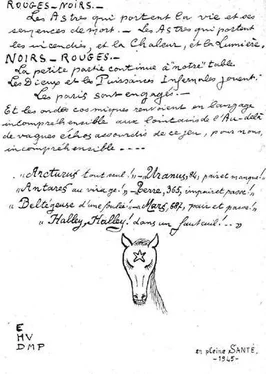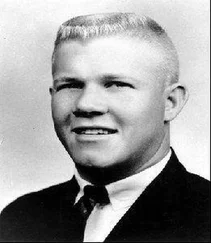.
Beauvoir, looking back, remembered being “filled with the joy of living. I regained my old conviction that life can and ought to be a real pleasure.”
ON March 19, Commissaire Massu began questioning the hairdresser Raoul Fourrier and the makeup artist Edmond Pintard individually about their involvement in the alleged escape organization.
Raoul Fourrier, a short man with white hair in a black beret, was brought into the commissaire’s office on the third floor first. Slumped into an armchair, Fourrier appeared nervous, cautious, and highly distrustful. He spoke in a low voice, as his eyelids fluttered and his fingers clutched the armrest. When the subject of Petiot was broached, Massu noted that the sweat beaded on Fourrier’s forehead and then disappeared into the wrinkles of his thick neck.
After an early silence, Fourrier told Massu that he had been a patient at Petiot’s clinic on rue Caumartin for seven years, and it was there that the doctor first alluded to the escape organization. The time, he believed, was May 1941, because they had been discussing the case of some unfortunate young cyclists who had been punished for crossing the line of demarcation. Petiot had then let it be understood that he knew how to pass Frenchmen into the unoccupied zone and then into South America. It was a dangerous operation that could be infiltrated at any time by the Gestapo. He kept a packed suitcase ready in case he should ever have to leave in a hurry.
Perhaps Fourrier, with his contacts at the hair salon, knew some people who would want to take advantage of this escape opportunity. Fourrier was surprised by this question, he said, claiming that he had always tried to avoid any action that would bring him into conflict with the authorities. But, as Fourrier put it, “the doctor is a charming man, seductive even.” He convinced the hairstylist that he was an active member of the Resistance helping fellow patriots escape “the vengeance of the Germans.”
At the same time, Petiot promised Fourrier a “nice commission.” Defensively, Fourrier told the commissaire that he had hesitated at the thought of his own personal gain. He was after all a patriotic Frenchman. Massu, unconvinced, returned to the subject of the organization. Fourrier freely admitted that he had agreed to help Petiot find recruits, and he sought out the assistance of his old friend, Edmond Pintard, who had many more contacts throughout the Parisian demimonde.
Fourrier told Massu of the client Charles Beretta, a safe choice since this man was already known from the Gestapo file. Since being released by the Germans in January 1944, Fourrier said that Petiot had twice tried to recruit him. When he refused, Petiot became angry and blamed Fourrier for causing their arrests by recommending Beretta.
After a short break in the interrogation, Massu asked about other people Fourrier had referred to Dr. Petiot. One of the first clients, he said, was known in the underworld as “Jo the Boxer,” “Iron Arm Jo,” “Jo la Ric,” or “Jo Jo.” A handsome, dark-haired thirty-something man with a broken nose and prominent scars under his chin, “Monsieur Jo,” as Fourrier called him, often dressed in a flashy style, with baggy, high-waisted, and tight-cuffed pegged trousers, and a long, loose coat with wide lapels and padded shoulders. He had been recruited by Pintard at a small bar on rue de l’Echiquier, in the heart of a notorious prostitution district along rue du Faubourg Saint-Denis.
Fourrier later picked him out from a series of police photographs. His real name was Joseph Réocreux, and he was, as Massu put it, “no choirboy.” Jo the Boxer had a long criminal record that ranged from robbery to procurement, with several terms in prison, from Lyon to Saint-Julien-en-Genevois in the Haute-Savoie on the Swiss border. He had four or five warrants out for his arrest, but there was a more pressing reason why he wanted to leave France.
Jo the Boxer had fallen out with the leader of one of the most violent and notorious criminal gangs in Occupied Paris: Henri Lafont (real name Henri Chamberlin). Alias “Henri Normand,” “Monsieur Henri,” or “The Boss,” the forty-two-year-old Lafont ran the group known informally as La Carlingue or the French Gestapo. The official name was Active Group Hesse, after a German SS officer under Helmut Knochen who’d looked after its foundation. Lafont’s men would not only engage in the usual racketeering and run bars, restaurants, and nightclubs; they would also kidnap, rob, ransom, and torture “enemies of the Third Reich”—and indeed they would often be rewarded by German authorities for their attacks. Lafont would ride through Paris in his white Bentley, always the latest model and usually with a mistress at his side. He seemed to prefer aristocrats and dancers.
In his palatial office on the second floor of 93 rue Lauriston, which was filled with the dahlias and rare orchids that he obsessively collected, Lafont ruled over a brutal and increasingly profitable criminal empire. He had an extensive network of agents and informers who kept him updated about affairs. Lafont insisted on order and discipline, demanding that his men remain régulier with him, that is, showing at all times, as one former member of the gang put it, “discretion, efficiency, team spirit, and a strict regard for instructions.” Jo the Boxer had broken this rule. He was donning a Gestapo uniform and, on his own initiative, committing a string of burglaries, thereby defrauding both the Third Reich and his own organization. Punishments in the cellar of Lafont’s gray stone building were more feared in the underworld than the tortures of the Gestapo.
As Fourrier described the events for Massu, Edmond Pintard had arranged for Jo to meet with Marcel Petiot at Café Mollard near Gare Saint-Lazare. Over a few glasses of brandy, they discussed Jo’s departure from Occupied Paris. Despite agreed protocol, however, Jo had not come alone. He brought along François Albertini, or “François the Corsican,” a thirty-four-year-old pimp from Vescovato Corsica with a prominent scar on his face. They were joined by two women, both prostitutes and mistresses: Lucienne or Claudia Chamoux (Lola, Lili, or Lulu), the older of the two and described as “dark-haired and elegant,” and Annette Basset, “Annette Petit,” “La Poute,” or “Little Bedbug,” a twenty-one-year-old from Lyon.
Petiot, known to his clients only as “Dr. Eugène,” refused to send four people at once on the escape route. He called the challenge, Fourrier recalled, “difficult, even impossible,” and insisted that the gang depart the country in two groups. As Jo had become suspicious of the doctor, apparently made uneasy by the look in Petiot’s eyes, which he told a friend “gave him the chills,” François the Corsican went first, accompanied by Jo’s girlfriend Claudia. The gangsters switched women, most likely to keep each other honest. Fourrier could not recall the exact time of the departure, though Jo and Annette had probably left at the end of October 1942.
But when the time for his departure neared, Jo the Boxer still had doubts. Pintard had tried to cheat him, he sensed, as indeed he had, arbitrarily doubling the departure fee and hoping to pocket the difference. Petiot, on hearing of these shenanigans, exploded, saying that this was a patriotic organization, not a commercial one, and threatened to end his working relationship with Pintard. This show of anger, however, had not removed Jo’s suspicions about the physician. And when news of François and Lulu’s arrival in South America proved slow to arrive, the gangster became more distrustful and restless.
At some point that autumn (neither Fourrier nor Pintard could recall the exact time), Petiot had produced a card or letter, purportedly written by François, relaying news of their arrival in Argentina. Pintard took it to the reluctant client, who then agreed to depart. Jo arrived, as planned, at Café Mollard, near Gare Saint-Lazare, with not one, but two women, Annette and a prostitute, whose name Fourrier could not recall. Rumors in bars referred to her as “Yoyo” or “Yvonne.” She was never identified.
Читать дальше












